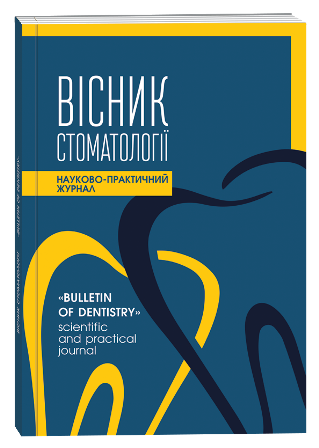MYOFUNCTIONAL CORRECTION OF ATYPICAL SWALLOWING USING FROGGYMOUTH DEVICE
DOI:
https://doi.org/10.35220/2078-8916-2024-52-2.21Keywords:
atypical swallowing, Froggymouth, myofunctional therapy, orthodontic treatment.Abstract
The transition from infantile to adult swallowing occurs before the age of 3 years. If infantile swallowing persists after the age when physiologically adult swallowing should appear, we can speak of atypical swallowing. Objective. To study the principles of application of the innovative myofunctional device Froggymouth (Fm). Materials and methods. An online search was conducted for published scientific studies on the use of the Froggymouth apparatus, which is used to solve the problem of atypical swallowing and myofunctional correction of the disturbed position of the tongue. Presentation of the main material. The works of Eric Kendal show that the correction of atypical swallowing should be based on the stimulation of subcortical connections and the inhibition of the sucking and swallowing chain. The Froggymouth appliance is a small, removable device made of a flexible thermoplastic elastomer. It is placed between the lips, separates them and inhibits sucking and swallowing, stimulating lip contractions to keep the device fixed. The device should be used for 15 minutes daily during play activities. The absence of bilabial contact prevents negative pressure in the mouth and therefore any use of suck-swallow to swallow saliva. Fm forces the child to discover a new way of swallowing through the subcortical pathway – by creating new synapses. Conclusions. Fm promotes automatic learning of a new swallowing program, requires less compliance from the child compared to traditional speech therapy, and treatment outcomes are more stable and long-lasting.
References
Quinzi, V., Nota, A., Caggiati, E., Saccomanno, S., Marzo, G., & Tecco, S. (2020). Short-Term Effects of a Myofunctional Appliance on Atypical Swallowing and Lip Strength: A Prospective Study. Journal of clinical medicine. No. 9(8). P. 2652. doi:10.3390/jcm9082652
Di Vecchio, S., Manzini, P., Candida, E., & Gargari, M. (2019). Froggy mouth: a new myofunctional approach to atypical swallowing. European journal of paediatric dentistry. No. 20(1). P. 33–37. doi: 10.23804/ejpd.2019.20.01.07
Fellus, P. (2015). Sucking and swallowing. Journal of Dentofacial Anomalies and Orthodontics. No.18. P. 110. doi: 10.1051/odfen/2014033
Fellus, P. (2016). How biochemistry and neurophysiology are involved in the re-education of deglutition. Japan Journal of Medicine. No. 2(1). P. 326-329. doi: 10.31488/jjm.1000134









